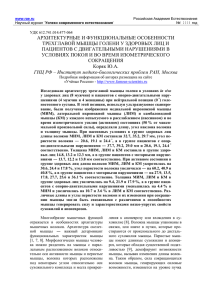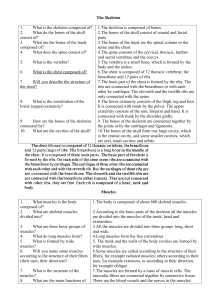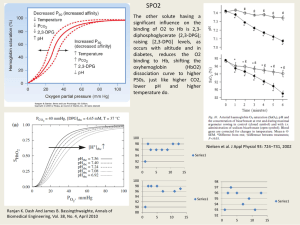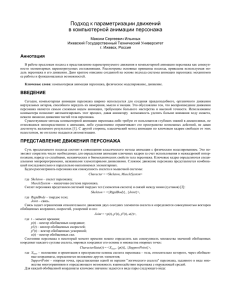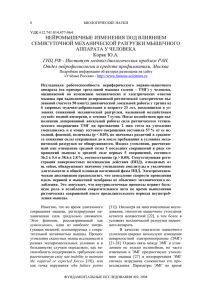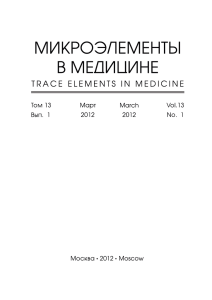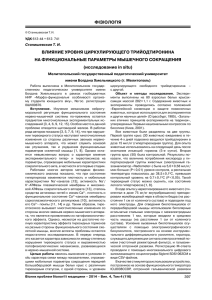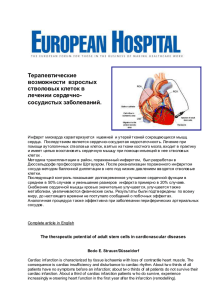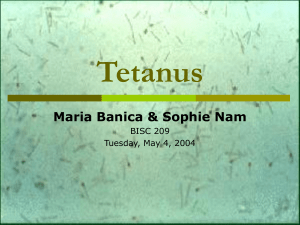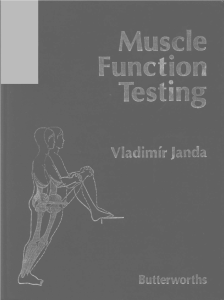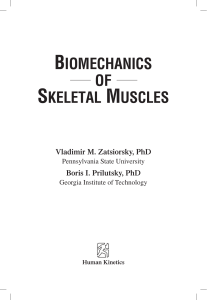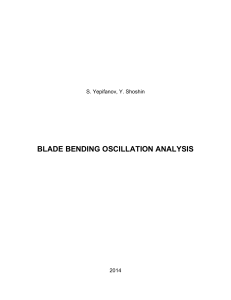NEURAL CONTROL OF FIBRILLAR MUSCLES IN BEES DURING SHIVERING AND FLIGHT
advertisement

J. exp. Biol. 159. 419-431 (1991)
Primed in Great Britain © The Company of Biologists Limited 1991
419
NEURAL CONTROL OF FIBRILLAR MUSCLES IN BEES
DURING SHIVERING AND FLIGHT
BY HARALD ESCH AND FRANZ GOLLER
Department of Biological Sciences, University of Notre Dame, Notre Dame,
IN 46556, USA
Accepted 28 May 1991
Summary
The big indirect flight muscles in the thorax of honeybees and bumblebees show
two modes of action: they contract with 'conventional' twitches in response to
slowly repeated muscle potentials and go into tetanus at higher muscle potential
frequencies. They can also contract much faster when quickly stretched (stretchactivation).
We observed contractions of DV (dorsoventral) and DL (dorsal longitudinal)
muscles optically with the help of a tiny mirror glued to the scutellum. We noticed
that DL muscles contracted much more than DV muscles during pre-flight warmup. During warm-up, muscle potential frequencies in DL muscles were higher
than in DV muscles (DL frequency/DV frequency =1.3), whereas during flight
the ratio reversed (DL/DV=0.8). The scutal fissure was completely closed during
shivering warm-up, apparently because the DL muscles shortened as much as they
could. As a consequence, fast antagonistic stretching was not possible. However,
the scutal fissure oscillated between wide open and closed during flight, and
antagonists could stretch each other quickly. Flight was started by highly
synchronized 'conventional' contractions of many muscle elements in DV
muscles. Antagonistic stretch-activation during flight led to faster shortening than
during shivering warm-up and synchronized all activated muscle elements to
produce maximal contractions.
The indirect flight muscles of bumblebees were in tetanic contractions during
shivering warm-up over the whole range of temperatures between 8 and 36°C.
These tetanic contractions probably prevented other researchers from observing
mechanical muscle activity. Our results, which for the first time allow us to detect
tetanic contractions directly, make it very improbable that non-shivering thermogenesis occurs in bumblebees, as has been proposed previously.
Introduction
Bees use two pairs of big fibrillar muscles, the dorsal longitudinal (DL) and the
dorsoventral (DV) indirect flight muscles in various behaviours. The most
important behaviours include warming of individuals in preparation for flight
(Esch, 1960; Heinrich, 1980), flight itself (Esch etal. 1975; Esch 1976), communal
Key words: flight muscle, neural control, bees, shivering, flight, Apis mellifera hgusttca,
Bombus impatiens.
420
H. ESCH AND F. GOLLER
hive heating (Himmer, 1932; Esch, 1960; Heinrich, 1987) and fanning during
regulation of hive temperatures (Lindauer, 1954). Honeybees also buzz their
wings while communicating in waggle dances (Esch, 1961; Wenner, 1962). Different contraction mechanisms must be used for different behaviours since thorax
vibrations might not be noticeable (heating) (Esch, 1964; Surholt et al. 1990),
wings might oscillate in short bursts of small vibrations (dance) or wings might
continuously beat up and down with considerable amplitudes (fanning and flight).
It is difficult to understand how motor neurones can control thefibrillarmuscles
in such diverse behaviours, since these muscles are asynchronous. Earlier
researchers could not find one-to-one relationships between muscle potentials and
contractions (Roeder, 1951; Pringle, 1957). It was assumed that asynchronous
muscle potentials turn on a 'stretch-activation mechanism', and that quick
stretches by antagonists during oscillations initiate contractions of muscles at the
molecular level (reviewed in Hoyle, 1983). How oscillations start in the very
beginning, however, and why one does not see muscle movement during warm-up
remained an unsolved problem. This led to unjustified speculations, for instance as
to how flight starts (Nachtigall, 1985) or how heat might be generated through nonshivering thermogenesis (Newsholme et al. 1972).
'Asynchronous' muscles can also perform 'conventional' twitches in which one
muscle potential causes one synchronous contraction, as we show in the following
observations. A series of muscle potentials leads to tetanic contractions. Wing or
thorax movements might be barely noticeable during these contractions (Bastian
and Esch, 1970; Surholt et al. 1990). These twitches can be used to produce
meaningful behavioural responses, such as heating, 'buzzing' or initiation of flight.
Materials and methods
Honeybees (Apis mellifera ligustica Spinola) were taken from the apiary in the
Department of Biological Sciences at the University of Notre Dame. Bumblebee
(Bombus impatiens Cresson) queens and workers were caught on flowers in front
of the Biology building. Individuals were held in a refrigerator at near 5°C prior to
an experiment until they cooled and became motionless. They were quickly
cemented to a small wooden rod by the notum using tacky wax. A small, very light
plastic mirror was glued to the middle of the scutellum. A horizontal bar of light
was focused on the center of this mirror from behind and above. This bar was
reflected onto the surface of a triangular photovoltaic cell. DV or DL contractions
moved scutellum and mirror about a horizontal elastic hinge across the notum
(Pringle, 1957). These reflected the projected light bar up (DV) or down (DL) the
triangular photocell. More or less surface area was illuminated, and photocell
output voltage represented angular movement of the scutellum and thus muscle
contractions (Fig. 1).
Up to six wire electrodes (diameter 50 nm, insulated except at the tip) were
inserted into dorsal longitudinal and dorsoventral flight muscles to observe as
many muscle units as possible. Muscle units close to an electrode were represented
Neural control offibrillar muscles
421
AflV
B
Fig. 1. Experimental set-up and preparation. (A) The honeybee is tethered to a rod
(1) with a reference electrode (R) in the head, wire electrodes in the dorsoventral
(DV) and dorsal longitudinal (DL) flight muscles and a thermocouple to determine
muscle temperature (7~,h). The light beam from the lamp (2) is reflected from a mirror
attached to the scutellum onto a photocell (3). (B) Enlarged view of the angular mirror
movement at the scutellum. Inset, the light bar moves up and down over the triangular
photocell producing an output voltage proportional to position.
by muscle potentials with large amplitudes, neighbouring units were represented
by much smaller muscle potentials. A reference electrode was pushed through a
small hole in the middle of the front of the upper head. Electrodes were
differentially
connected to UFI model 2122 bio-amplifiers (input
impedance>10MQ). Outputs of these amplifiers were connected to an IBM
DACA input board in a Tandy 1000A computer. The board was used with
UNKELSCOPE level 2+ data acquisition software. Samples were taken with
sampling rates of either 0.5 or lms for 2-4s and stored on floppy disks. The
original analog signals were also recorded on an instrumental tape recorder
(Vetter model B, in FM mode) and could be replayed for additional analysis. Data
were evaluated with UNKELSCOPE editing features or transferred to
LOTUS123 worksheets for further processing.
A copper-constantan thermocouple (diameter 50pern), waxed to the middle of
the frontal dorsal thorax, determined muscle temperature (Esch, 1960). A second
thermocouple lem above the animal recorded environmental temperature. A
BAT-12 digital thermometer (Sensortek) was used to read thoracic temperature.
A Baily BAT-4 thermometer was used to determine air temperature. In the
measurements in which temperature differences between the two muscle pairs
were determined, the Baily thermometer was used in differential mode.
Results
Warm-up and flight
Shortening of DV and DL muscle units caused appropriate movements of the
422
H . ESCH AND F . GOLLER
A
DV
DL
Sc
2mV
Fig. 2. Recordings from a bumblebee showing single muscle potentials without
antagonistic action and the corresponding twitch (in situ muscle shortening) (Sc).
(A) Shortening of the dorsal longitudinal muscle at r,h=13°C (DL); (B) shortening of
the dorsoventral muscle at 13°C (DV).
mirror attached to the scutellum. The mirror was considered to be in 'zero
position' when DL and DV muscles were inactive (no muscle potentials). The light
beam moved upwards from zero (dorsal side) when muscle potentials occurred
only in DV muscles. Muscle potentials restricted to DL muscles deflected the
beam downwards (ventral side) (Fig. 2). Shortening restricted to DL muscles
alone occurred much more frequently than shortening of DV muscles alone.
Trains of muscle potentials with different amplitudes could often be seen using
one electrode. Potentials with different amplitudes must represent separate
muscle units because recruitment of potentials with discrete amplitudes in the
middle of existing recordings always led to additional shortening. Most recordings
reflect more or less synchronized shortening of more than one muscle unit. If we
increased the number of electrodes in one muscle from one to three we were able
to record 65 % more muscle potentials. Muscle potential frequencies of all
detected elements were very similar in a particular recording, but units in different
parts of the muscle were not necessarily synchronized. When using only one
electrode, we occasionally observed mirror movements, but no corresponding
potentials.
Shortening times in non-flight recordings were much longer than those during
flight (Fig. 3). Summation became very marked at muscle potential frequencies
above a few hertz. Shortening time, and thus extent of summation, was also very
sensitive to changes in muscle temperature (Fig. 3). In a few cases where only one
muscle group was active, the time from maximal shortening to return to rest length
could also be seen, and it was significantly longer than shortening time (Fig. 2).
DL and DV muscles were often excited by dissimilar muscle potential
frequencies. Since these muscle groups contracted against each other, the balance
of contractions shifted to the side of the muscle pair (DL or DV) that had a higher
Neural control offibrillar muscles
100
423
I
•
•
Shivering
o Flight
I
40 •
20 -
I
o
X
o
o
oo
o
• o
O o O C
•
1
10
20
30
•
•
•
40
Thoracic temperature (°C)
Fig. 3. Duration of wingbeat half-cycle (data from Esch, 1976, closed circles, and from
F. Goller, unpublished results, open circles) and shortening time ( ± 1 S . E . M ) of
conventional twitches (onset to peak displacement) as a function of muscle temperature in honeybees. Wingbeat half-cycles were determined from the time between
minimum and maximum lift production of an animal tethered to a flight balance.
muscle potential frequency (see beginning of flight vs beginning of heating) (Figs 4
and 5). The extent of mirror movement reflected this balance between DV and DL
muscle contractions.
These observations could be visually verified, and additional information could
be gained. We looked at the lateral side of the thorax of a honeybee fixed in the
apparatus through a stereo dissection microscope (25x amplification). The scutal
cleft near the wings (Snodgrass, 1956) was nearly closed when DV and DL muscles
were inactive (zero position=no muscle potentials). The scutal cleft closed
further, probably until a skeletal protrusion finally stopped movement (morphological details in Pringle, 1957) when muscle potential frequency in DL muscles
was higher than in DV muscles, such as during heating. The mesoscutellar arm had
slid under the mesoscutum as far as it could and pushed the notum upwards. The
mesoscutellar arm is moved through the mesophragma by contractions of dorsal
longitudinal muscles. Contraction of DL muscles thus stretched the DV muscles.
The scutellar fissure frequently opened briefly at low shivering rates, especially at
body temperatures between 20 and 30°C. The ratio between DL and DV
(DL/DV) muscle potential frequencies changed to values less than 1.0 at these
instances.
The scutellar cleft opened wide at the beginning of flight when oscillations
started. The DV muscles stretched the DL muscles and the cleft oscillated
between wide open and closed during flight. The cleft stayed open briefly as the
amplitude of oscillations diminished at the end of flight and closed immediately
afterwards.
424
H . ESCH AND F . GOLLER
DV
Fig. 4. (A) Muscle potentials in dorsoventral (DV) and dorsal longitudinal (DL) flight
muscles of honeybees and in situ muscle movement (Sc) during the transition from
warm-up to flight (thoracic temperature=33°C). Note different values of the ratio of
DL/DV potential frequencies in a (1.6) and b (0.7). (B) Expanded view of the very
beginning of flight (marked with a bar in A) showing the synchronized stimulation of
both muscle groups corresponding to the beginning of oscillations.
Recordings of mirror movements and muscle potentials, as well as visual
inspection, provide the following explanation for the events during shivering. The
mirror is in zero position when DV and DL muscles are inactive, and the
mesonotal suture is nearly closed. The mirror subsequently tilts downwards at the
beginning of heating (mesonotal suture closed to stop), and the balance of muscle
shortening tips towards contraction of DL muscles (Fig. 5).
Muscle potential frequencies in DL muscles are higher than those in DV
muscles during shivering (ratio of DL/DV frequencies near 1.3). This high
DL/DV ratio persists for various muscle potential frequencies observed during
shivering at temperatures between 10 and 40°C in honeybees and between 8 and
Neural control offibrillarmuscles
425
Sc
0.5 s
5mV
Fig. 5. Beginning of a heating episode. Muscle potential frequency in dorsal longitudinal (DL) muscles is higher than in dorsoventral (DV) muscles. Note the downward
trend of the scutellar trace (in situ muscle response) (Sc), indicating shortening of the
DL muscle. Synchronized muscle responses of lower amplitude than individual
potentials can also be seen.
Table 1. Ratio of muscle potential frequencies in DL and DV flight muscles
(DL/DV) for honeybees (recordings from five individuals) and bumblebees (three
individuals)
DL/DV ratio
Honeybee
Mode
Shivering
Flight
Buzzing
Bumblebee
Mean
N
Mean
N
1.34±0.25
0 .86±0.13
1.08±0.12
17
27
11
1.38±0.34
0.70±0.08
13
6
Data for bumblebees were determined from recordings in Heinrich and Kammer (1973).
N refers to the number of determinations from recordings that lasted approximately Is.
Values are mean±s.D.
DL, dorsal longitudinal; DV, dorsoventral.
40CC in bumblebees (Table 1). The shift in DL/DV frequency ratio is illustrated in
Fig. 4A, where a transition from heating (DL/DV=1.6) to flight (DL/DV=0.7) is
shown for one individual. The higher activity of DL muscles during heating is also
reflected in a higher muscle temperature. At an ambient temperature of 24°C the
temperature of DL muscles was about 0.6°C higher than the temperature of DV
muscles at the beginning of shivering. The difference amounted to 2.6°C when the
DV muscles reached 36°C. This occurred in all three honeybees that we tested.
426
H . ESCH AND F . GOLLER
DL
DV
5mV
Fig. 6. Muscle activation in dorsal longitudinal (DL) and dorsoventral (DV) muscles
leading to a short buzz (in situ muscle response in Sc). A DL muscle potential causes a
'conventional' shortening (slow) indicated by downward movement (Sc, a); a DV
muscle potential causes faster upward movement (b); the following DL potential
causes still faster shortening and stretch activation of the DV muscle (c).
Buzzing in honeybees and bumblebees
During shivering, and often immediately following flight, short bursts of fast
contractions could be observed. These bursts were similar to bursts of 'buzzing'
sounds during wagging runs in honeybees dances (Esch, 1961). They consisted of
between one and several fast DV/DL contractions with amplitudes somewhat
smaller than those in flight, as judged by mirror movements. Wings were held in a
V-shaped position and did not beat up and down far. Fig. 6 shows the beginning of
such a buzzing phase. At a, DL units became active and DL muscles contracted.
At b, DV units fired and the summed contraction of DL muscles was very quickly
counteracted. Muscles were pulled back to near zero position. Another burst of at
least three groups of DL units at c contracted the DL muscle faster than in a. The
velocity was high enough to start oscillations through 'stretch-activation'. The
average DL/DV ratio during buzzing was 1.08, indicating equal activation of both
muscle groups (Table 1).
Discussion
Flight muscle contractions and scutellar movement
Snodgrass (1956) explained the connection between contractions of fibrillar DV
and DL flight muscles and scutellar movements. The DL muscles are attached
frontally to the notum of the second thoracic segment and rostrally to the
Neural control offibrillar muscles
All
postphragma of the mesothorax. Their contraction tilts the scutellum downwards.
The DV muscles are affixed dorsally to the same notum as the DL muscles. They
connect ventrally directly to the sternum. The scutellum tilts upwards when they
contract. Esch and Bastian (1968) and Bastian and Esch (1970) connected
transducers directly to the attachment sites of DL and DV muscles and
demonstrated that potentials in DV and DL muscles led to shortening of the
respective muscles. Shortening of muscles monitored with the mirror on the
scutellum is indistinguishable from direct transducer observations.
In muscles directly attached to a transducer, muscle potential frequencies
between 5 and 10 Hz cause tetanus-like fusion of single contractions. Similar
observations were made by Ikeda and Boettiger (1965). They attached the DL
muscles of bumblebees directly to a transducer and recorded their contractions in
response to stimulation of the motor nerve. The DL muscles went into smooth
tetanus at stimulus frequencies near 10 Hz.
Failure to see scutellar movement at high shivering rates, where muscle
potential frequencies are above 10 Hz, is probably the result of tetanic fusion of
contractions. It could also be caused by the pull of the DL muscles against a
mechanical stop.
Various types of muscle contraction
The big fibrillar flight muscles can produce two types of muscle contractions the conventional twitch and the stretch-activated fast contraction (Esch and
Bastian, 1968; Bastian and Esch, 1970). These muscles respond to motor neurone
discharge with conventional twitches when they are not stretch-activated. The
shortening time in these twitches is much smaller than the time required to return
to rest length (Fig. 5; Ikeda and Boettiger, 1965). When activated muscles are
stretched quickly, development of tension lags behind length change (as first
described by Boettiger, 1957a,£>). Under these conditions, fast stretches result in
fast contractions. Mutual stretching of antagonists then leads to the well-known
oscillations (for a review see Hoyle, 1983). One should note, however, that during
oscillations lengthening following the contraction of a muscle pair is not 'relaxation', but stretching by the antagonist. Thus, shortening and lengthening times
are very similar. Because contractions of various muscle elements within a muscle
during conventional twitches are normally not synchronized (Fig. 5), the amplitude of contractions is not big. Stretch activation in DV and DL muscles during
oscillations ensures that all muscle units are synchronized to contract at the same
time. Thus, maximal contraction amplitude can be achieved. It would be very
difficult to obtain such a degree of synchronization by strictly neuronal, as opposed
to mechanical, means in these muscles.
Shivering versus flight
Snodgrass (1956) gave a detailed description of the mechanical movements of
the thorax capsule and the scutellum in honeybees resulting from contractions of
DV and DL muscles, and he also discussed the potential role of smaller direct
428
H . E S C H AND F. GOLLER
muscles in the flight apparatus. However, Pringle (1961) pointed out that
Snodgrass's description of the role of smaller direct and accessory muscles during
flight must be largely incorrect, since only fibrillar muscles can contract at the high
frequency of the wingbeat.
Bees heat by shivering with the large fibrillar flight muscles but these muscle
movements cannot easily be detected (Esch, 1964; Bastian and Esch, 1970;
Kammer and Heinrich, 1972; Heinrich and Kammer, 1973; Surholt etal. 1990).
Heinrich and Kammer (1973) proposed that bumblebees contract antagonists
synchronously and thus largely eliminate oscillations. Such synchronous muscle
potential patterns are commonly seen in bumblebees. Frequently, however, the
antagonistic muscles are not activated synchronously, and muscle potential
patterns alone would not then explain why the muscles still do not oscillate.
Similarity, muscle potential patterns in honeybees never show synchrony as in
bumblebees. Observations in the present study of intact bees and in previous
studies of muscle preparations (Ikeda and Boettiger, 1965) show 'conventional'
twitches during shivering, lasting much longer than contractions during flight,
specifically in their return to rest length. Shivering muscles go into smooth tetanus
at fairly low muscle potential frequencies. Furthermore, during shivering, DL
muscles contract more than their antagonists. Unequal excitation of DL and DV
muscles pushes the structures connected to the mesophragma (which is moved by
DL muscles) against a skeletal stop. Oscillations are thus avoided as muscle
contractions increase. No muscle movements are seen at higher muscle potential
frequencies, both because summation keeps the DL muscles in tetanus and
because the muscles are contracted against a mechanical stop. There is not enough
summation at low muscle potential frequencies, however, and muscle movements
can then be detected.
Whenever DV muscles are pre-stretched by DL muscles, and a greater number
of DV muscle units contract simultaneously, faster ('stretch-activated') twitches of
DL muscles can occur. Sometimes stretch-activated twitches are big and fast
enough to stretch-activate the antagonists sufficiently, and a few big oscillations
can be seen, as for instance during buzzing. The increasing intensity of mutual
stretch-activation can be observed as the velocity of the contractions increases
over a few oscillations.
Non-shivering thermogenesis
Tetanic contractions during heating were found in all of the ten bumblebees we
observed over the temperature range from 8°C (where muscles stop functioning)
(Goller and Esch, 1990) to 40°C. Thoracic heating without muscle potentials and
resulting contractions never occurred. This observation is particularly important,
since a number of reports suggest that bumblebees might produce heat by nonshivering thermogenesis (NST) (Newsholme et al. 1972; Greive and Surholt, 1990;
Surholt et al. 1990). According to this model, flight muscles use phosphofructokinase and fructose-l,6-diphosphatase reactions in 'futile cycling', thus generating
heat without contractions by splitting ATP. The model suggests further that Ca 2+
Neural control offibrillar muscles
429
release during muscle contractions shuts NST off by inhibiting the fructose-1,6diphosphatase reaction (Clark etal. 1973; Greive and Surholt, 1990). This
hypothesis must be incorrect since flight muscle contractions, and thus Ca 2+
release, can always be seen when heat is produced (Esch et al. 1991).
Initiation of oscillations
The uncoordinated twitches in DL and DV muscles during shivering are too
small and too slow to provide mutual stretch-activation, as required for the fast
muscle oscillations during flight. Our observations explain how oscillations begin.
Synchronous contraction of a great number of muscle elements in the DV muscles
results in a twitch of large amplitude (see synchronized multi-unit potentials in
Fig. 4B). This contraction leads to stretch-activation in the DL muscle, which is
also activated by a synchronized multi-unit potential. This multi-unit spike always
occurs approximately half of a wingbeat cycle after the DV multi-unit potential.
The DL muscle, in turn, stretches the DV muscle, and oscillations begin (see also
Esch and Bastian, 1968). The mechanical synchronization provided by mutual
stretching evidently increases the effectiveness of stretch-activation, since the
shortening velocity of DV and DL muscles increases to a maximum within a few
wingbeats (Fig. 7). This increase in velocity can be attributed to both an increase
in amplitude and a faster shortening time. Once initiated, oscillations keep going
as long as the muscles involved are activated sufficiently by motor nerves.
Sometimes the general level of activation is just high enough to support a few
30
10
20
30
Wingbeat number
40
50
Fig. 7. Shortening velocity of dorsal longitudinal (DL) and dorsoventral (DV) muscles
for all wingbeats in a representative recording of a flight episode. Amplitudes were
measured as distances between the minimum and maximum light deflections caused by
scutellar movement. They were calibrated against actual length changes of DV and DL
muscles (see Esch and Bastian, 1968).
430
H . E S C H AND F. G O L L E R
oscillations, as during buzzing. High muscle potential frequencies during flight
ensure continuous oscillations. Oscillations stop only at the end of flight, when
electrical activity in DV and DL muscles ceases for approximately 50-150 ms.
The possible role of 'starter muscles', direct muscles that could provide the first
stretch of the DL or DV muscles in the initiation of flight, has been reviewed for
Calliphora by Nachtigall (1985). But, even in Calliphora, removal of all presumptive starter muscles had no effect, since '[elimination tests have not resulted in
definite proof of the necessity or existence of such a starting muscle' (quote from
Nachtigall, 1985). Such muscles could not exist in bees because all the direct and
accessory indirect muscles of the mesothorax are of 'normal' (slow) structure.
They contract tonically and not fast enough to stretch-activate fibrillar flight
muscles and thus start oscillations (Pringle, 1961). We suspect that oscillations in
the flight muscles of flies begin in a similar way to those in bees.
References
J. A. AND ESCH, H. (1970). The nervous control of the indirect flight muscles of the
honeybee. /. comp. Physiol. 67, 307-324.
BOETTIGER, E. G. (1957a). The machinery of insect flight. In Recent Advances in Invertebrate
Physiology (ed. B. T. Scheer), pp. 117-142. University of Oregon Publications.
BOETTIGER, E. G. (1957£>). Triggering of the contractile process in insect fibrillar muscles. J. cell.
comp. Physiol. 46, 370-371.
CLARK, M. G., BLOXHAM, D. P., HOLLAND, P. C. AND LARDY, H. A. (1973). Estimation of the
fructose diphosphatase-phosphofructokinase substrate cycle in the flight muscle of Bombus
affinis. Biochem. J. 134, 589-597.
ESCH, H. (1960). Ueber die Koerpertemperaturen und den Waermehaushalt von Apis mellifica.
Z. vergl. Physiol. 43, 305-335.
ESCH, H. (1961). Ein neuer Bewegungstyp im Schwaenzeltanz der Bienen. Naturwissenschaften
48, 140-141.
ESCH, H. (1964). Ueber den Zusammenhang zwischen Temperatur, Aktionspotentialen und
Thoraxbewegungen bei der Honigbiene (Apis mellifica L.). Z. vergl. Physiol. 48, 547-551.
ESCH, H. (1976). Body temperature and flight performance of honey bees in a servomechanically controlled wind tunnel. /. comp. Physiol. 109, 265-277'.
ESCH, H. AND BASTIAN, J. A. (1968). Mechanical and electrical activity in the indirect flight
muscles of the honey bee. Z. vergl. Physiol. 58, 429-440.
ESCH, H., NACHTIGALL, W. AND KOGGE, S. N. (1975). Correlations between aerodynamic
output, electrical activity in the indirect flight muscles and wing positions of bees flying in a
servomechanically controlled wind tunnel. J. comp. Physiol. 100, 147-159.
ESCH, H., GOLLER, F. ANDHEINRICH, B. (1991). How do bees shiver? Naturwissenschaften 78 (in
press).
GOLLER, F. AND ESCH, H. (1990). Comparative study of chill-coma temperatures and muscle
potentials in insect flight muscles. J. exp. Biol. 150, 221-231.
GREIVE, H. AND SURHOLT, B. (1990). Dependence of fructose-bis-phosphatase from flight
muscles of the bumblebee {Bombus terrestris L.) on calcium. Comp. Biochem. Physiol. 97B,
197-200.
HEINRICH, B. (1980). Mechanisms of body-temperature regulation in honeybees, Apis mellifera.
J. exp. Biol. 85, 61-87.
HEINRICH, B. (1987). Thermoregulation by individual honeybees. In Neurobiology and Behavior
of Honeybees (ed. R. Menzel and A. Mercer), pp. 102-111. Berlin, Heidelberg, New York,
London, Paris, Tokyo: Springer Verlag.
HEINRICH, B. AND KAMMER, A. E. (1973). Activation of the fibrillar muscles in the bumblebee
during warm-up, stabilization of thoracic temperature andflight.J. exp. Biol. 58, 677-688.
BASTIAN,
Neural control offibrillar muscles
431
HIMMER, A. (1932). Die Temperaturverhaeltnisse bei den sozialen Hymenopteren. Biol. Rev. 7,
224-253.
HOYLE, G. (1983). Muscles and Their Neural Control. New York, Chichester, Brisbane,
Toronto, Singapore: John Wiley & Sons.
IKEDA, K. AND BOETTIGER, E. G. (1965). Studies on the flight mechanism of insects. II. The
innervation and electrical activity of the fibrillar muscles of the bumble bee, Bombus. J. Insect
Physiol. 14, 779-789.
KAMMER, A. E. AND HEINRICH, B. (1972). Neural control of bumblebee fibrillar muscle during
shivering. J. comp. Physiol. 78, 337-345.
LINDAUER, M. (1954). Temperaturregulierung und Wasserhaushalt im Bienenstaat. Z. vergl.
Physiol. 36, 391-432.
NACHTIGALL, W. (1985). Calliphora as a model system for analysing insect flight. In
Comprehensive Insect Physiology, Biochemistry and Pharmacology, vol. 5 (ed. G. A. Kerkut
and L. I. Gilbert), pp. 571-605. Oxford, New York, Toronto, Sydney, Paris, Frankfurt:
Pergamon Press.
NEWSHOLME, E. A., CRABTREE, B., HIGGINS, S. J., THORNTON, S. D. AND START, C. (1972). The
activities of fructose diphosphatase in flight muscles from the bumble-bee and the role of this
enzyme in heat generation. Biochem. J. 128, 89-97.
PRINGLE, J. W. S. (1957). Insect Flight. 133pp. Cambridge: Cambridge University Press.
PRJNGLE, J. W. S. (1961). The function of the direct flight muscles in the bee. Proc. Xlth Int.
Congr. Em. (Vienna 1960) 1, 660.
ROEDER, K.D. (1951). Movements of the thorax and potential changes in the thoracic muscles of
insects during flight. Biol. Bull. Mar. biol. Lab., Woods Hole 100, 95-106.
SNODGRASS, R. E. (1956). Anatomy of the Honey Bee. 334pp. Ithaca, New York: Comstock
Publishing Associates.
SURHOLT, B., GREIVE, H., BAAL, T. AND BERTSCH, A. (1990). Non-shivering thermogenesis in
asynchronous flight muscles of bumblebees? Comparative studies on males of Bombus
terrestris, Xylocopa sulcatipes and Acherontia atropos. Comp. Biochem. Physiol. 97A,
493-499.
WENNER, A. M. (1962). Sound production during the waggle dance of the honey bee. Anim.
Behav. 10, 79-95.
